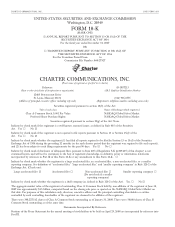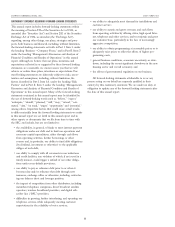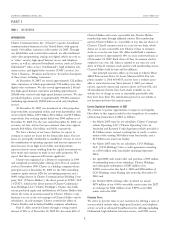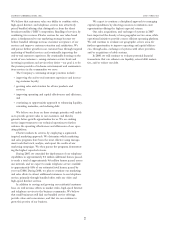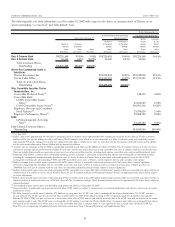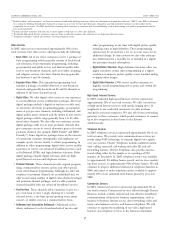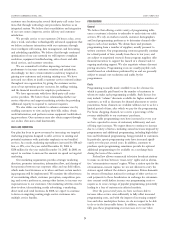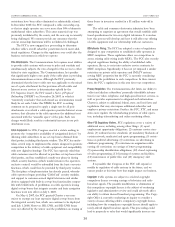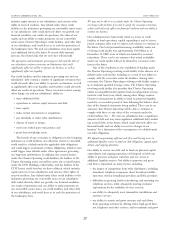Charter 2007 Annual Report Download - page 19
Download and view the complete annual report
Please find page 19 of the 2007 Charter annual report below. You can navigate through the pages in the report by either clicking on the pages listed below, or by using the keyword search tool below to find specific information within the annual report.
Sale of Advertising
In 2007, sale of advertising represented approximately 5% of our
total revenues. We receive revenues from the sale of local
advertising on satellite-delivered networks such as MTV», CNN»
and ESPN». In any particular market, we generally insert local
advertising on up to 40 channels. We also provide cross-channel
advertising to some programmers.
From time to time, certain of our vendors, including pro-
grammers and equipment vendors, have purchased advertising
from us. For the years ending December 31, 2007, 2006 and
2005, we had advertising revenues from vendors of approxi-
mately $13 million, $17 million, and $15 million, respectively.
These revenues resulted from purchases at market rates pursuant
to binding agreements.
PRICING OF OUR PRODUCTS AND SERVICES
Our revenues are derived principally from the monthly fees
customers pay for the services we offer. We typically charge a
one-time installation fee which is sometimes waived or dis-
counted during certain promotional periods. The prices we
charge for our products and services vary based on the level of
service the customer chooses and the geographic market. Most
of our pricing is reviewed throughout the year and adjusted on
an annual basis.
In accordance with the Federal Communications Commis-
sion’s (“FCC”) rules, the prices we charge for video cable-related
equipment, such as set-top boxes and remote control devices,
and for installation services, are based on actual costs plus a
permitted rate of return in regulated markets.
We offer reduced-price service for promotional periods in
order to attract new customers and to promote the bundling of
two or more services. There is no assurance that these customers
will remain as customers when the promotional pricing period
expires. When customers bundle services, they enjoy prices that
are lower per service than if they had only purchased a single
service.
OUR NETWORK TECHNOLOGY
We employ the hybrid fiber coaxial cable (“HFC”) architecture
for our systems. HFC architecture combines the use of fiber optic
cable with coaxial cable. In most systems, we deliver our signals
via fiber optic cable from the headend to a group of nodes, and
use coaxial cable to deliver the signal from individual nodes to
the homes passed served by that node. On average, our system
design enables typically up to 500 homes passed to be served by
a single node and provides for six strands of fiber to each node,
with two strands activated and four strands reserved for spares
and future services. We believe that this hybrid network design
provides high capacity and signal quality. The design also
provides two-way signal capacity for the addition of future
services.
HFC architecture benefits include:
kbandwidth capacity to enable traditional and two-way video
and broadband services;
kdedicated bandwidth for two-way services, which avoids
return signal interference problems that can occur with two-
way communication capability; and
ksignal quality and high service reliability.
The following table sets forth the technological capacity of our
systems as of December 31, 2007 based on a percentage of
homes passed:
Less than 550
megahertz 550 megahertz
750
megahertz
860/870
megahertz
Two-way
activated
5% 5% 43% 47% 93%
Approximately 95% of our homes passed are served by
systems that have bandwidth of 550 megahertz or greater. This
bandwidth capacity enables us to offer digital television, high-
speed Internet services, telephone service and other advanced
services.
Through system upgrades and divestitures of non-strategic
systems, we have reduced the number of headends that serve our
customers from 1,138 at January 1, 2001 to 316 at December 31,
2007. Because headends are the control centers of a cable system,
where incoming signals are amplified, converted, processed and
combined for transmission to the customer, reducing the number
of headends reduces related equipment, service personnel, and
maintenance expenditures. As of December 31, 2007, approxi-
mately 90% of our customers were served by headends serving at
least 10,000 customers.
As of December 31, 2007, our cable systems consisted of
approximately 199,100 aerial and underground miles of coaxial
cable, and approximately 57,000 aerial and underground miles of
fiber optic cable, passing approximately 11.8 million households
and serving approximately 5.6 million customers.
MANAGEMENT OF OUR SYSTEMS
The corporate office, which includes employees of Charter, is
responsible for coordinating and overseeing overall operations
including establishing company-wide policies and procedures.
The corporate office performs certain financial and administrative
functions on a centralized basis such as accounting, cash man-
agement, taxes, billing, finance, human resources, risk manage-
ment, telephone, payroll, information system design and support,
internal audit, legal, purchasing, customer care, marketing, com-
munications, programming contract administration, Internet ser-
vice, network and circuits administration, and oversight and
coordination of external auditors and consultants. The corporate
office performs these services on a cost reimbursement basis
pursuant to a management services agreement. Our field opera-
tions are managed within three divisions. Each division has a
divisional president and is supported by operational, financial,
legal, customer care, marketing and engineering functions.
CUSTOMER CARE
Our customer care centers are managed centrally, with the
deployment and execution of end-to-end care strategies and
initiatives conducted on a company-wide basis. We have eight
CHARTER COMMUNICATIONS, INC. 2007 FORM 10-K
8


